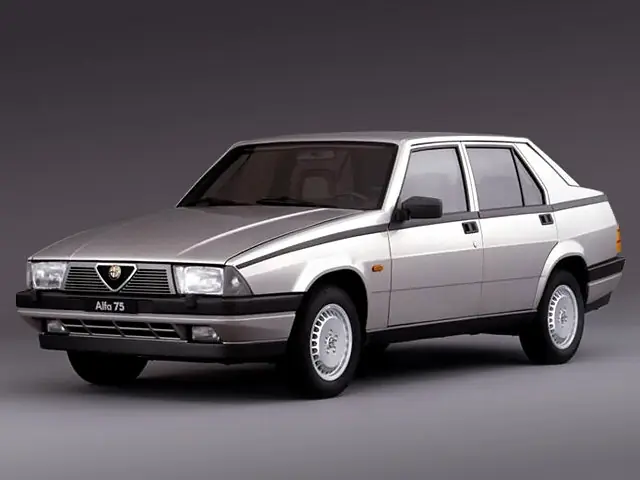The Alfa Romeo 75 marks a pivotal moment in Italian automotive history. Released in 1985, this sports sedan carried the weight of being the last independently developed Alfa Romeo before the Fiat takeover. Its angular design and driver-focused philosophy represented the culmination of decades of engineering excellence.
The 75 emerged during a transformative period for European sports sedans. While German manufacturers focused on luxury and refinement, Alfa Romeo chose a different path – creating a car that prioritized driving dynamics and character above all else. This approach would later influence an entire generation of sports sedans.
A Testament to Italian Engineering
The foundation of the 75’s appeal lies in its unique engineering approach. The transaxle layout, with a rear-mounted gearbox, created near-perfect 50:50 weight distribution – a feat that even many modern sports cars struggle to achieve. The chassis designers prioritized handling precision over comfort, resulting in a car that truly came alive on winding roads.
The build quality surpassed expectations for Italian cars of the era. Unlike some of its contemporaries, the 75’s body panels demonstrated remarkable resistance to corrosion, thanks to improved manufacturing processes and better materials.
“After 30 years, my 75 V6 still feels as solid as the day it left the factory. The body has held up remarkably well, with only minor surface rust in typical trouble spots. It’s a testament to how well these cars were built.” – Michael Richardson, Classic Alfa enthusiast
The interior layout broke conventional design norms. The dashboard, with its driver-centric orientation and unique instrument cluster placement, showcased Italian creativity at its finest. Every control fell naturally to hand, though some ergonomic choices might raise eyebrows by today’s standards.
Heart of a Lion: The Powerplant Options
The engine lineup deserves special attention, particularly the crown jewel – the 2.5-liter V6. This powerplant represented Italian engineering at its finest, delivering not just performance but also character. The sound alone justified the purchase for many enthusiasts.
Here’s what made the engine range so special:
- twin-spark technology in four-cylinder variants provided exceptional efficiency;
- V6 models offered smooth power delivery across the rev range;
- diesel options combined economy with surprising performance;
- mechanical simplicity contributed to long-term reliability.
The mechanical soundtrack became more intoxicating as the revs climbed, encouraging drivers to explore the upper reaches of the tachometer. Few engines of the era could match the V6’s combination of smoothness and character.
Driving Dynamics That Define an Era
The 75’s handling characteristics set new standards for sports sedans. The rear-wheel-drive platform, combined with the transaxle layout, created a uniquely balanced driving experience. Turn-in response remained sharp and predictable, while the chassis communicated road conditions with remarkable clarity.
“The steering feel is something special – you get this constant stream of feedback through the wheel. Modern cars with electric power steering just can’t replicate this kind of connection.” – James Taylor, Vintage Racing Driver
The brake system, featuring inboard rear discs, provided strong stopping power with excellent pedal feel. This setup, though complicated to service, demonstrated Alfa Romeo’s commitment to engineering excellence over maintenance simplicity.
The Preservation Challenge
Finding a well-maintained Alfa Romeo 75 today requires patience and dedication. These cars demand regular maintenance and understanding of their quirks. The parts availability landscape presents both challenges and opportunities:
- mechanical components remain relatively accessible;
- interior trim pieces have become increasingly scarce;
- aftermarket support continues from specialist suppliers;
- some electronic components require sourcing from dedicated specialists.
The Alfa Romeo 75 represents more than just another sports sedan from the 1980s. It embodies the last expression of independent Alfa Romeo engineering and design philosophy. This car captured the essence of what made Alfa Romeo special – a perfect blend of passion and precision.
These machines continue to appreciate in value, particularly well-maintained examples with documented history. Their rising status among collectors reflects growing recognition of their historical significance and driving pleasure.
| Pros | Cons |
|---|---|
| Exceptional handling balance due to transaxle layout | Limited parts availability for certain components |
| Characterful V6 engine with distinctive sound | Interior ergonomics can feel dated |
| Strong corrosion resistance for its era | Complex maintenance procedures for some systems |
| Growing collector appeal and value appreciation | Electrical systems can be temperamental |
| Driver-focused design and feedback | Fuel consumption can be high in V6 models |
| Unique styling that stands out from contemporaries | Interior trim pieces becoming scarce |
| Excellent weight distribution | Specialist knowledge often required for maintenance |
The Alfa Romeo 75 stands as a testament to a bygone era of automotive design and engineering. Its combination of driver engagement, character, and historical significance makes it an increasingly appealing classic car choice. While ownership requires commitment and understanding, the rewards of experiencing pure, unfiltered Alfa Romeo DNA make it worthwhile for the dedicated enthusiast.

